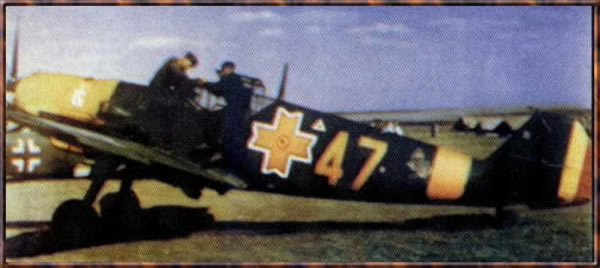
|
|
|
|
|
|
|
|
|
|
|
|
|
|
|
|
|
|
The Messerschmitt Bf-109E fighter
|
|
|

Here's a nice color photo of a Romanian Bf-109E fighter
|
|
|
A Romanian Bf-109E
|
Tehnical data of the Messerschmitt Me-109E3
|
Wingspan
|
9.87 meters
|
|
Length
|
8.65 meters
|
|
Height
|
2.5 meters
|
|
Weight (empty)
|
2125 kg
|
|
Weight (loaded)
|
2660 kg
|
|
Maximum speed at 4500 meters
|
540 km/h
|
|
Climbs to 6000 meters
|
7 minutes and 45 seconds
|
|
Service ceiling
|
10500 meters
|
|
Range
|
480 km / 660 km
|
|
Engine
|
Daimler Benz DB 601A rated at 1175HP
|
|
Armament
|
Two 7.92 mm MG17 machine guns plus 3 MG/FF 20 mm cannons
|
|
Crew
|
1
|
Tehnical data of the Messerschmitt Me-109E4
|
Wingspan
|
9.87 meters
|
|
Length
|
8.65 meters
|
|
Height
|
2.5 meters
|
|
Weight (empty)
|
2125 kg
|
|
Weight (loaded)
|
2665 kg
|
|
Maximum speed at 4500 meters
|
560 km/h
|
|
Climbs to 6000 meters
|
7 minutes and 45 seconds
|
|
Service ceiling
|
10500 meters
|
|
Range
|
480 km / 660 km
|
|
Engine
|
Daimler Benz DB 601A rated at 1175HP
|
|
Armament
|
Two 7.92 mm MG17 machine guns plus 2 MG/FF 20 mm cannons
|
|
Crew
|
1
|
Tehnical data of the Messerschmitt Me-109E7
|
Wingspan
|
9.87 meters
|
|
Length
|
8.65 meters
|
|
Height
|
2.5 meters
|
|
Weight (empty)
|
2125 kg
|
|
Weight (loaded)
|
2665 kg
|
|
Maximum speed at 4500 meters
|
560 km/h
|
|
Climbs to 6000 meters
|
7 minutes and 45 seconds
|
|
Service ceiling
|
11000 meters
|
|
Range
|
480 km / 660 km
|
|
Engine
|
Daimler Benz DB 601N rated at 1200HP
|
|
Armament
|
Two 7.92 mm MG17 machine guns plus 3 MG/FF 20 mm cannons
|
|
Payload
|
One SC 250 kg bomb or 4 SC 50 kg bomb
|
|
Crew
|
1
|